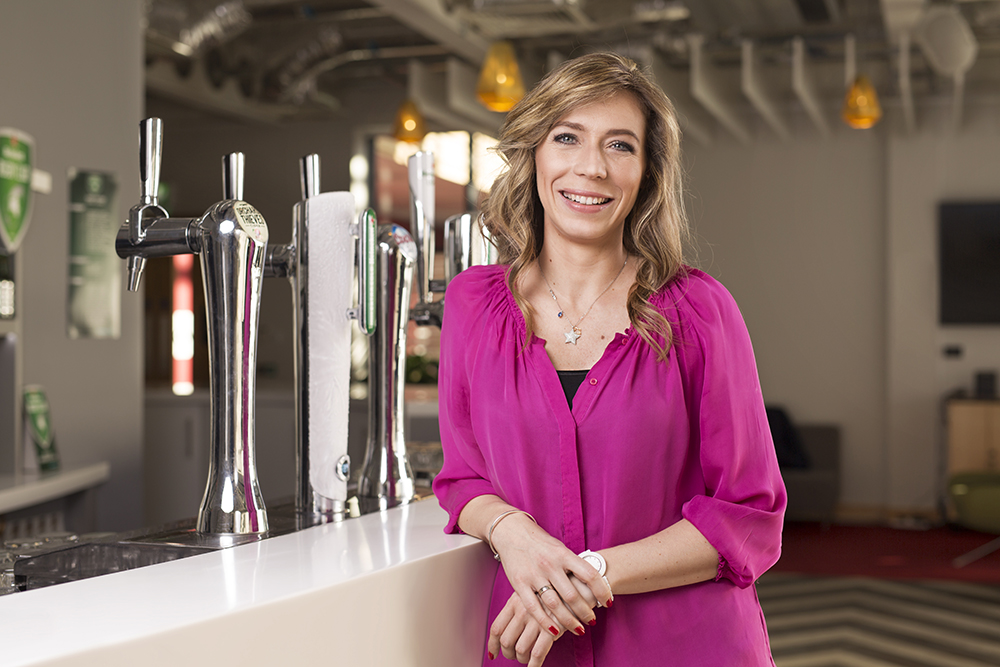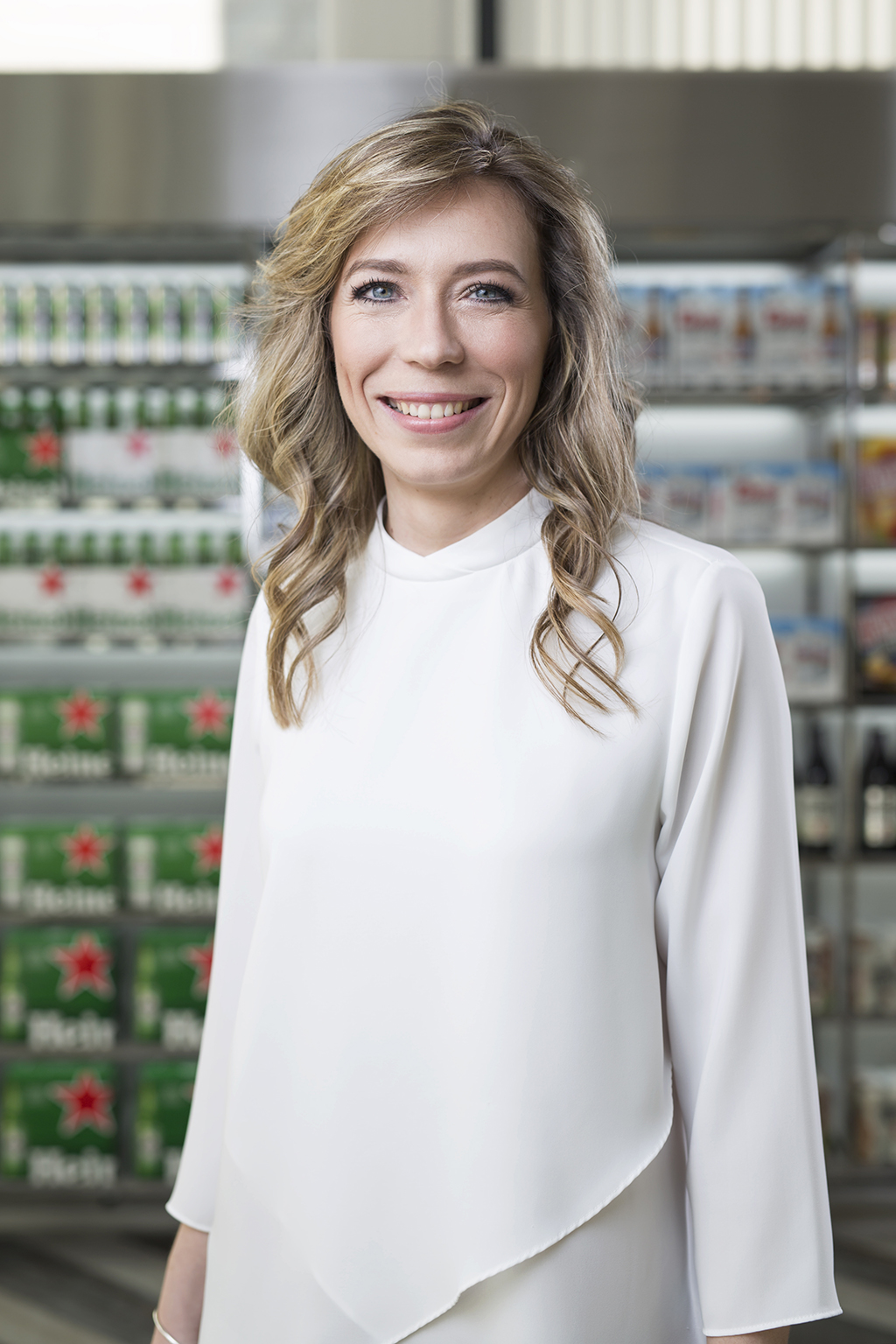
With the launch of several new brands over the past few months, Heineken Ireland’s marketing director Radina Shkutova talks to John McGee about innovation, the cider and beer market and why marketers need take greater control of their brands.
It’s an interesting but challenging time to be involved in the Irish drinks industry. For so long the key players in both the spirits and beer market co-existed relatively peacefully and the ensuing equilibrium that was established ensured that there was money to be made by all while punters had a reasonable choice of beer, whiskey, gin or, whatever you are having yourself, to choose from.
Then the world changed.
Over the last ten years or so, plucky start-ups have begun to challenge the old brand hegemony. Microbreweries and micro-distilleries have sprung up in every county in Ireland producing everything from craft IPAs, stouts and lagers right through to quirky sounding whiskeys, gins and vodkas.
A lot of this was in response to shifting consumer lifestyles, preferences and tastes in addition to a desire by consumers for greater choices and often healthier options like low or zero alcohol alternatives.
It’s probably fair to say that the sheer proliferation of craft breweries and distilleries around the country took the industry by surprise and, initially anyway, they were slow to respond. More recently, however, they have been very active on the product innovation front and armed with vast marketing and advertising budgets, they are not going to let the parvenu pretenders eat their lunch any time soon. One only has to look at the flood of new products that have been launched by the likes of Irish Distillers and Diageo (or the hipper sounding St James Gate) over the past 18 months.
With the largest lager brand in the market, Heineken Ireland has always kept a close eye of national, regional and global trends, says marketing director Radian Shkutova, over the last three years it too has stepped up its investment in innovation and new product development with as many as three new beers hitting pubs and the shelves of off-licences over the past few months.
“If you go back to the company’s founders, innovation is in the company’s DNA and it’s at the core of everything we do,” she says.
“So, even putting aside product innovation, we aim to bring innovation into everything that we do internally in our processes, how we work together between the different functions and how we break down silos. We are still on a journey and we will get there. But in terms of pure product innovation, we have achieved a lot over the last few years, particularly in the cider market which is very exciting and growing,” she says.
In the space of just three years, she adds, Orchard Thieves had managed to carve out a market share of around 11.7% by the end of 2017 and this is growing every year, albeit by single digits.
It may not be well known, but Heineken is the largest cider manufacturer in the world with a number of brands in its stable including the likes of Strongbow, Blind Pig, Stassen, Old Mout, Bulmers and of course Orchard Thieves which made its successful debut on the Irish market in 2016 and has since been rolled out in many other international markets.
“Microbreweries and micro-distilleries have sprung up in every county in Ireland producing everything from craft IPAs, stouts and lagers right through to quirky sounding whiskeys, gins and vodkas.”
In the case of the Bulmers brand, however, it’s Bulmers in the UK and not Ireland where C&C owns and distributes the brand and has the lion’s share of the market sewn up. The Bulmers brand in the UK is a long-established one and became part of Scottish & Newcastle in 2003. In 2008, however, Scottish & Newcastle was acquired by Heineken. Now Heineken is going after the Irish market again with the launch of a new twice-pressed cider called Appleman’s which is aimed at wresting a bigger chunk of market share from C&C.
“The beer market in Ireland is a mature one but we believe there is more growth in the Irish cider market and since we entered it with Orchard Thieves, we have actually grown and invigorated the category by attracting new customers to it. Since we launched it in Ireland, it is also enjoying global success in other markets where it has been localised. We are now the second biggest after Bulmers in the Irish market and the number one globally. So, as a category, we see it continuing to grow and there is still huge potential in it, particularly when you compare it to the beer market. If you look at the beer market in Europe, for example, consumption has been decreasing slightly over the past few years. So, for us, cider is where we can gain growth,” she says.
While the Irish cider market may have been singled out for some extra love from the Heineken marketing department, Shkutova says it hasn’t ignored its core beer brands which had a market share of around 26.7% at the end of 2017, a 1.2% improvement on 2016.
“Heineken, of course, is our main brand and is sold in over 190 markets around the world and Ireland is one of the company’s top ten markets globally and this says a lot about the strength of the brand,” she says.
Capitalising on the strength of the brand, the company has been busy launching different variants of Heineken aimed at different parts of the potential market, including Heineken Light, a low-alcohol beer; Heineken 0.0, which has no alcohol and a series of premium “wild lagers” called H35, H32 and H41, all of which are made using wild yeast that was sourced in far-flung places like Patagonia, the Himalayas and the Blue Ridge Mountains in the USA.
“Again, it’s all about innovating and looking at the different consumer occasions where people can enjoy a trusted Heineken brand, whether it’s a non-alcoholic one, one with low alcohol or one of our premium richer-tasting beers like H41,” she says.
At a time when the drinks industry is still concerned about the proposed introduction of the Public Health (Alcohol) Bill and is under pressure from the wider health lobby, the introduction of Heineken 0.0, its non-alcoholic variant, fits in well with its long-running campaign – which features former racing driver Jackie Stewart- urging people not to drink and drive. But the company has also spotted that sales of non-alcoholic beer in Europe have been rising by around 5% a year for the past few years.
The Bill is currently with the EU and, assuming there are no additional changes or amends to it, it could be another year, possibly longer before it ever gets enacted in Ireland.
The Alcohol Beverage Federation of Ireland (ABFI), which represents the drinks industry, has been vociferous in its opposition to the Bill and the implications it has on a company’s ability to market and advertise its products to consumers. The Bill places extensive restrictions on the content and placement of alcohol advertising, including the banning of drinks advertisements in public parks, on public transport, and within 200 metres of school grounds. It will also impose severe creative limitations on what beer brands like Heineken can say in their advertising.
A 2017 report by economist, Jim Power, entitled “The Potential Impact on Irish Media of the Public Health (Alcohol) Bill 2015”, also noted that the Bill will result in a loss of €20m in annual advertising revenue for Irish media. Power also noted that international research does not provide conclusive evidence that a ban or severe restriction on alcohol advertising would lead to a reduction in the consumption of alcohol, particularly among young people.
“As I understand it, the discussions on the Alcohol Bill are drawing to a close but exactly how it will play out is still uncertain. However, what I can say is that, given the importance that the role of advertising plays in new product development and innovation, the proposed advertising restrictions are likely to have an impact on the sector, in particular for start-ups and new innovations,” says Shkutova.
“Changing behaviour is key to solving the issue of alcohol misuse and this can only be achieved if all stakeholders work together with this common goal. Parts of the draft Bill, particularly those relating to advertising and some of the latest labelling rules, will have no effect on changing behaviour. From a marketing point of view, Heineken Ireland will continue to drive our responsibility agenda through our Enjoy Heineken Responsibility platform and our latest campaign “When You Drive Never Drink,” she adds.
In a marketplace where brand loyalty has been severely tested with the arrival of so many different alternative products, loyalty is something that Heineken invests considerable resources in.
“We do track brand loyalty and it’s very important to us. It’s not like we are as good as our last gig. We have to earn and re-earn our consumers loyalty with every pint we sell. We can’t always rely on that kind of loyalty, it has to be constantly earned. We need to make sure that we attract more consumers to our brands and keep them there and we look at how many consumers in Ireland are drinking the Heineken brand and whether we are gaining consumers or losing them,” she says.
A key part of the marketing and customer retention thinking in recent years has been its involvement in a number of festivals and sporting events. These include the likes of the UEFA Champions League, the European Rugby Champions Cup, the Rugby World Cup, Formula 1 and, of course, Longitude and Electric Picnic in Ireland. It also runs the online platform Heineken Rugby Club (HRC) which is a way of connecting with rugby fans and rewarding their loyalty with opportunity to win match tickets, complimentary beers as well as things like cinema and restaurant deals. The latter recently picked up a Gold award in Best Use of Sponsorship & Product Placement at the Media Awards 2018.
“We’ve always been very active in sponsorship and experiential and we are very much committed to deliver outstanding experiences, because these are places where our consumers are going I believe it has one of the strongest assets on the market in Ireland. But it’s also up to us to ensure that we are there to offer the perfect pint in a great environment and create that unique brand experience that we try to offer,” says Shkutova.
As a leading global brand, Heineken is not immune to the many changes that are taking place in the wider marketing and communications world where large multinational brands like P&G are trying to take a lot more ownership of their brands at every stage of the customer journey rather than overly relying on third parties like external agencies.
“When I talk to my peers in different companies, I think we as marketers agree that we need to move from just communications and advertising to fully owning our brands and that includes everything from the positioning of the brand, innovation, communication, advertising as well as looking at things like pricing, visibility and availability. Marketers, I think need to own their brands across all the different touch points that the consumer sees. So, I think there is a big challenge ahead for the industry. I know in our industry, for example, we can no longer rely on just advertising anymore and that means we are going to have to be a lot more focused on everything to do with our brands and consumers. And we will get there,” she concludes.
Who is Radina Shkutova?
 Radina Shkutova joined Heineken Ireland in 2016 from the Heineken Zagorka Brewery in Bulgaria, where she was marketing director. She replaced the former marketing director Sharon Walsh who was promoted to what was then a new role as global director for cider at the group’s Amsterdam headquarters.
Radina Shkutova joined Heineken Ireland in 2016 from the Heineken Zagorka Brewery in Bulgaria, where she was marketing director. She replaced the former marketing director Sharon Walsh who was promoted to what was then a new role as global director for cider at the group’s Amsterdam headquarters.
Having initially worked in account management with Publicis Marc in Sofia she went to work for Heineken in 2005 as brand manager on Heineken and other global brands and her team drove significant business growth for the company in Bulgaria.
While working for Heineken Bulgaria, her team also developed the group’s cider strategy which kicked off with the introduction of Strongbow to the market in 2015. This was followed by the introduction of Apple Thief cider in 2016 which was based on Heineken Ireland’s Orchard Thieves. The campaign was spearheaded by Shkutova and delivered an impressive 25% market share of the cider category in year one. For her efforts, she was awarded the Advertiser of the Year Award in Bulgaria in both 2014 and 2016.
First published in Irish Marketing Journal (IMJ March 2018)© to order back issues please call 016611660




















